BISAC NAT010000 Ecology
BISAC NAT045050 Ecosystems & Habitats / Coastal Regions & Shorelines
BISAC NAT025000 Ecosystems & Habitats / Oceans & Seas
BISAC NAT045030 Ecosystems & Habitats / Polar Regions
BISAC SCI081000 Earth Sciences / Hydrology
BISAC SCI092000 Global Warming & Climate Change
BISAC SCI020000 Life Sciences / Ecology
BISAC SCI039000 Life Sciences / Marine Biology
BISAC SOC053000 Regional Studies
BISAC TEC060000 Marine & Naval
The Zuibaiji River located west of Fukuoka city has a rich natural environment and history but various problems as well. In order to solve some of these problems, stakeholders need to observe and talk about the river. Also recently, the "MIZBERING Project" has been opening up possibilities for renewing riverside uses of lost activities from the old days in Japan. This project is being conducted by citizens, companies and government administrations with an interest in waterside areas. The First MIZBERING Zuibaiji River Conference was held to discuss the issues of the Zuibaiji basin. Its purpose was to visit and search out the nature and history of the entire Zuibaiji basin from its mountains to the sea and to rediscover the Zuibaiji basin, and finally to discuss future plans for the Zuibaiji basin and Imazu tidal flat at its outlet. After visiting the Zuibaiji basin, we discovered a problem in that the Zubaiji Dam is holding not only water but also sand, and this problem affects the environment of the Zuibaiji basin such as its ecosystem and topography. Finally, we provided a venue for the local people to discuss problems and future plans for the Zuibaiji basin.
Zuibaiji River, MIZBERING Project, Imazu Tidal Flat, Oyster Reef, Horseshoe Crab, Black-faced spoonbill.
I. INTRODUCTION
The Zuibaiji River located at west of Fukuoka city in Japan is a Class B river from Mt. Ihara of the Sefuri mountainous district. The Zuibaiji River joins Kawahara river, Akasaki river and Sioi river and flows into Imazu Bay. The length of Zuibaiji river channel is 13.2km and the basin area is 52.6km2 (Fig.1). The Zuibaiji River is small but has a rich natural environment and history. The upper reach of Zuibaiji River is Zuibaiji Dam. The middle reach has a gentle-sloping landform and farmland. Historically, according to a description in the Gishi-wajin-den, the middle reach has Itokoku remains. And Imazu Tidal Flat at its estuary is a spawning ground and habitat for horseshoe crabs and is a wintering spot for black-faced spoonbills. Just by looking, the Zuibaiji Basin has a rich natural environment, but various problems as well. In order to solve some of these problems, stakeholders need to observe and talk about the river.
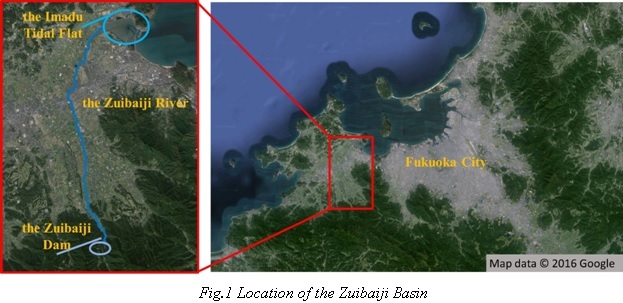


In Japan, “MIZBERING Project” is recently getting into the news. The project has been opening up possibilities for renewing riverside uses of lost activities from the old days in Japan. This project is being conducted by citizens, companies and government administrations with an interest in waterside areas. Also, “MIZBERING” is a coined term of “MIZBE (the water’s edge) + RING” and “MIZBE (the water’s edge) + R (Renovation) + ING”, owing to this project, beautiful townscapes hybrid water’s edge and town and new prosperities are being created in various areas in Japan (Fig.2).


.jpg)
Thus, the First MIZBERING Zuibaiji River Conference was planned and conducted to discuss the issues of the Zuibaiji basin. Its purpose was to visit and search out the nature and history of the entire Zuibaiji basin from its mountains to the sea and to rediscover their connections and problems the Zuibaiji basin has, and finally to discuss future plans for the Zuibaiji basin and Imazu Tidal Flat at its outlet.
II. DETAIL SCHEDULE OF MIZBERING ZUIBAIJI RIVER CONFERENCE
On November 22 and 23, 2015, the First MIZBERING Zuibaiji River Conference was held with field excursions and lectures. A total of 27 people participated in this 2-day conference. The schedule is shown in Table 1. About details of the implementation, we visited the Zuibaiji Dam, basin and Imazu Tidal Flat by bus with the purpose to rediscover the connections between the nature and history and problems that the Zuibaiji basin may face. Then, each field was explained by using panels. On the first day, the guest speaker was Prof. Yuko Koike and she explained the ecology of black-faced spoonbills such as their breeding place and wintering spot. She told us that compared to the old days, the black-faced spoonbill population wintering in Imazu Tidal Flat has recently increased and is stable. On the second day, Mr. Koutaro Takemura was the invited speaker. As the representative director of Water Forum NPO, he explained a historical transition of a river basin and a basic plan of water cycle at the lunch seminar. At the end of the conference, participants were asked to give their thoughts about their visit and discussed what they would want to do in Zuibaiji basin and Imazu Tidal Flat.
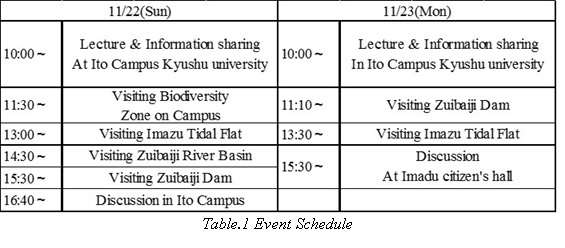
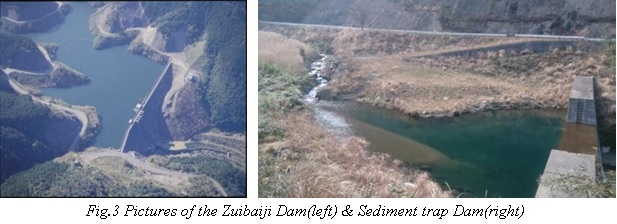
The Zuibaiji Dam was completed in 1977. It is a small concrete gravity dam and has functioned as a multipurpose dam used as an adjustment to flood and its water utilization capacity serves water supply and water for unspecified use. On the other hand, the dam is stopping not only he water flow, but also sand flowing into downriver of the Zuibaiji River, Imazu Tidal Flat and Imazu Bay, accordingly. As a result, the sediment accumulates within the dam more rapidly than expected (Fig.4). To solve this problem, Fukuoka Prefecture made two sediment trap dams at the upper reach of the Zuibaiji Dam (Fig.3). This slowed the sedimentation rate in the Zuibaiji Dam, but the problem did not end here - the sand did not flow into downriver. Thus, we need to consider a comprehensive sediment management to get rid of the accumulation of the sediment from the dam and move it into the river.
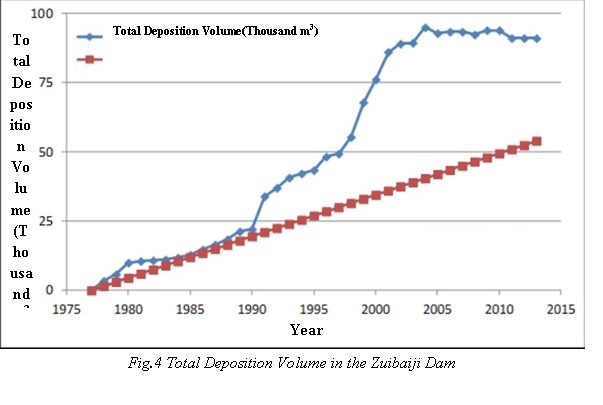
By visiting the Zuibaiji Dam, participants will become aware that the Zuibaiji Dam is an important existence to control water output for our life and is stopping not only water but also a necessary sand discharge into downriver and the sea.
IV. TRANSITION AND ACTIVITY OF THE ZUIBAIJI RIVER
Previously, a hearing survey was conducted for Mr. Makoto Mitoma, a chairman of the Society of Protecting the Zuibaiji River. The Society of Protecting the Zuibaiji River has been doing an environment beautification campaign by cleaning the Zuibaiji River and planting Equinox Flower for about 50 years because they want to take a good care of the river they inherited from their ancestors, to recover a rich natural environment, and to create the town where nature and people can harmoniously coexist. Also, when Mr. Mitoma was a child, the Zuibaiji River had much water volume and biodiversity such as salmons, eels (Anguilla japonica) and sweet fish. But recently, the river turned into a poorer condition with a reduced water volume after the construction of the Zubaiji Dam and with the increase in domestic waste water into the river after a real estate development.

V. ECOLOGICAL SYSTEM AND ACTIVITY THE IMAZU TIDAL FLAT
.jpg)
The Imazu Tidal Flat is located at the estuary of the Zuibaiji River (Fig.5). Its sandy beach on the northeast is an egg-laying site for horseshoe crabs from July to August. Also, the Imazu Tidal Flat is a wintering spot for not only many wild birds but also black-faced spoonbills, an endangered species. Back in old days the Imazu Tidal Flat was teemed with eelgrass and various species such as gobies and partridges. But the sand supply on the beach had decreased and the beach had changed to muddy tidal flat. This is because water and sand volume supply into the Imazu Tidal Flat decreased after the construction of the Zuibaiji Dam in 1977. The number of horseshoe crab eggs had decreased significantly owing to a road widening construction in 1988. Because the tidal flat got muddy and domestic waste water flowed in, the oyster reefs formed on it. Under this condition, the local people have done many activities to recreate habitat for horseshoe crab larvae, for example, and they collected oyster shells to make compost from them and to form a site for dwarf eelgrass and resting areas for wild birds (Fig.6).

VI. DISCUSSION
Finally, we discussed problems and future plans for the Zuibaiji basin with the conference participants (Fig.7). As a result, we confirmed a few things below. First, the fact that the Zuibaiji Dam is stopping not only water but also sand. This has affected ecological system of the Zuibaiji basin and the Imazu Tidal Flat. Now we need to be clearly aware that the sand moves from the mountain to ocean through a river. In this way, we realize that it is important for stakeholders to cooperate together when they take actions at the Zuibaiji basin. In order to achieve this, we should improve ways to involve people in various social positions into discussions and consider how to bring fishermen (ocean) and farmers (land) to communicate effectively.
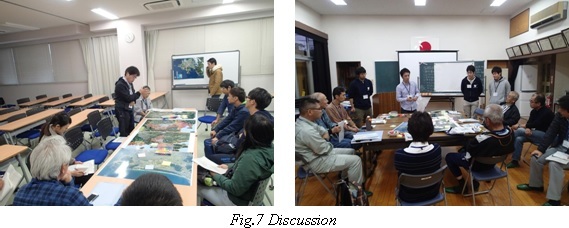
With these as a background, we discussed future plans for us to do at the Zuibaiji River and the Imazu Tidal Flat (Fig.8). First, a river is a lifeline to the sea and Kyushu University will clarify the mechanism and system of the Zuibaiji basin. Additionally, in order to supply nutrient into the ocean, we want to plant broad-leaved trees at riverside of the Zuibaiji River and to make the Zuibaiji River habitable for many species such as salmons and sweet-fishes just like the old days. On the Imazu Tidal Flat, we want to brand the oyster reefs and start oyster huts in Imazu. Oyster shells from oyster huts and culled oysters from the reefs can be used effectively for compost and landfills. The others include various ideas such as creating eelgrass farms, making Satoumi for the coexistence of humans and nature, and being able to enjoy marine sports like sapp and kayak owing to the existing yacht basin.
VII. CONCLUSION
This was the first event at the Zuibaiji River like the MIZBERING Project. And it is important for stakeholders such as government, local residents and scholars to cooperate together without the vertical division when taking any actions at the Zuibaiji basin.
VIII. ACKNOWLEGEMENT
I would like to give heartfelt thanks to Prof. Yuko Koike, Mr. Koutaro Takemura, Yasuhiro Yoko and Youiti Ide whose lectures and suggestions were of inestimable value for my study. Special thanks also go to Ms. Iwasaki whose comments made enormous contribution to my work. Finally, thank you for Ports and Harbours Bureau, West Ward office of Fukuoka City, prefectural land Rural Infrastructure Department of Fukuoka and Maebaru office.
1. MIZBERING Administration Office, “Chartulary of MIZBERING World Conference,” 2015(in Japanese)
2. Fukuoka Prefecture HP, “Introduction Zuibaiji Dam,” (http://www.pref.fukuoka.lg.jp/contents/zuibaiji.html)
3. Fukuoka Preference Zuibaiji Dam Office Data, “Total Deposition Volume in The Zuibaiji Dam,” 2015(in Japanese)







